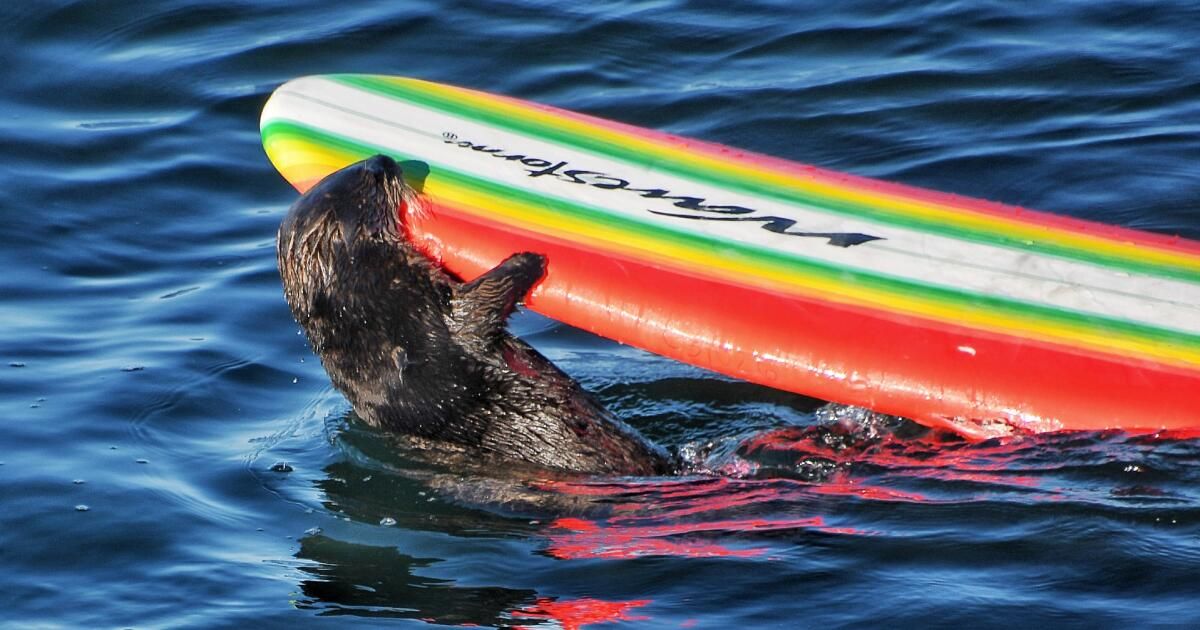Social media lit up this past holiday weekend with the return of Santa Cruz's most famous marine mammal: the surfboard-stealing Otter 841.
“841 is back at 831 on Steamer Lane” boasted Mark Woodward on social media platform Woodward is a social media influencer known as Native Santa Cruz.
Observers at the Santa Cruz Longboard Union Memorial Day contest captured photos and videos of an otter calmly cleaning itself atop a board it had hijacked, which it peacefully shared with a stunned surfer.
Woodward said that although that creature was probably 841 (the behavior seemed entirely consistent), he could not provide a 100% positive identification; she couldn't see the distinctive blue tag attached to her left fin after she was born and then released from captivity.
However, he had seen the 6-year-old otter in the surrounding area over the weekend (and captured several photos that he posted online) after a five-month hiatus. She disappeared with her puppy when December storms swept across the Pacific and battered California's central coast.
“She also disappeared the year before,” he said, noting that she was nowhere to be seen between September 2022 and early June 2023. “She seems to be her employer.”
She said she didn't see her puppy with her over the weekend, but that was to be expected. Otters typically nurse their young for only six to eight months before weaning them and sending them crabbing, fishing, and interacting independently with their environment.
Otter 841 was seen accompanied by a small otter, presumably her pup, during October and November, putting her baby's age at around 7 or 8 months.
“Sea otters are naturally cautious around people, but some individuals exhibit aggressive tendencies that can be exacerbated by pregnancy, illegal feeding or repeated exposure to close approaches by people,” said Vanessa Morales, spokesperson for the Fish and Life Service. US Sylvester, in a statement.
He said there were no immediate plans to capture 841 and asked the public to be “very cautious when recreating around sea otters.”
“If a sea otter approaches you, it is abnormal behavior. It is your responsibility to avoid and discourage these interactions,” he said.
Otter 841 attracted national attention last year as it chased surfers and their boards around the legendary surf breaks that hug the California coast between the lighthouse and the Santa Cruz Pier. For months, federal officials tried to capture her, but she eluded their attempts. They finally gave up and urged surfers, swimmers and boaters to stay away from the curious otter.
Woodward said government agencies contacted him directly, pleading with him to tell his tens of thousands of followers on X, Instagram and Facebook to stay away from 841.
“For your safety, stay at least 50 feet away from sea otters and all marine life, it's the law and also common sense, so please help keep them safe,” he wrote on Facebook.
Sea otters were once found from Mexico to Alaska, and even Japan, according to the Monterey Bay Aquarium website. Today, that range has become much smaller. In California, only about 3,000 otters live along a 300-mile stretch from Half Moon Bay to Point Conception. There is a much larger population in Alaska and some are still seen in Russia.
Sea otters were once hunted for their fur, leading to their dramatic decline, and are now listed as a threatened species.
It is unclear what drives 841's aggressive behavior with surfboards. Biologists noted that his mother had exhibited similar behaviors, suggesting that 841 learned from his mother, inherited those tendencies, or perhaps a little of both.
Her mother had been fed by people in the wild, which may have led to her comfort around humans, as well as her curiosity. Wildlife officials say it is dangerous to feed wild animals not only because of concerns about physical contact, but it can also create this type of behavior, which ultimately endangers the animal.
Morales, the federal spokesperson, had recommendations for people who encounter 841 while surfing, boating or swimming:
If an otter approaches: Stay calm and leave immediately. Do not attempt to photograph, touch, pet or feed the otter.
If the otter chases you or someone you are with: Wave your arms and make noise. Hit the water with your oar, oar, or hand. Try throwing water at the otter. If you're in a boat or board, hit the boat with a paddle or your hand.
If none of that works and the otter persists or comes aboard: Use a paddle or other object to block the otter or push it off your boat. Morales noted that federal laws protect sea otters and that harassing or injuring a sea otter is illegal. However, a gentle nudge is considered acceptable if it was used as a last-ditch effort to protect you and the otter from harm. She said you can also try Rock your kayak or board, turning it into an unstable platform. He said people should not attempt to move the otter with their hands and in no way attempt to touch or pet it or pause to take photographs. As soon as the otter leaves the boat, leave.
If you are out with your dog and encounter an otter: Never allow your dog to chase, harass, play with or otherwise interact with an otter, he said. A dog can hurt an otter, and an otter can hurt or kill a dog. Additionally, interactions can result in the transmission of diseases that could harm the otter, your dog, or you.
He asked people to recognize that posting videos and photos of sea otter encounters only promotes similar interaction with wildlife by others.
“Be careful when sharing,” he said.












